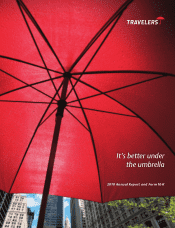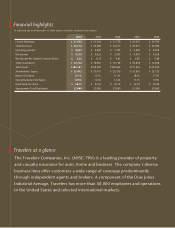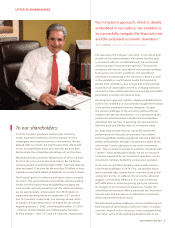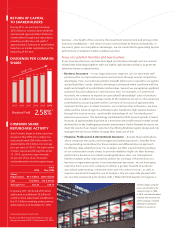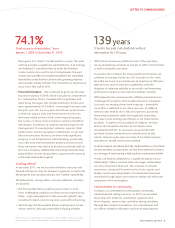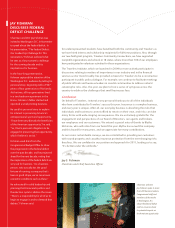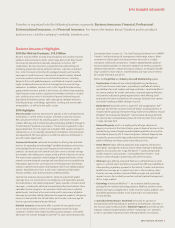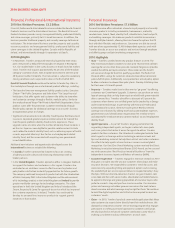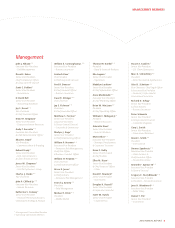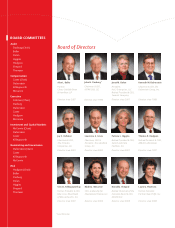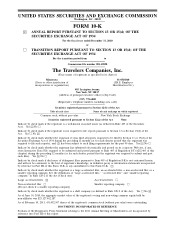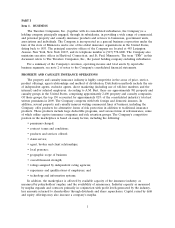Travelers 2010 Annual Report Download - page 3
Download and view the complete annual report
Please find page 3 of the 2010 Travelers annual report below. You can navigate through the pages in the report by either clicking on the pages listed below, or by using the keyword search tool below to find specific information within the annual report.
2010 ANNUAL REPORT 3
LETTER TO SHAREHOLDERS
To our shareholders:
In 2010, Travelers produced another year of strong
results against the backdrop of what continues to be a
challenging and complex economic environment. We are
pleased with our results not only because they refl ect well
on our accomplishments this year, but also because they
demonstrate the competitive advantages of our franchise.
We produced net income per diluted share of $6.62, up from
$6.33 in the prior year and second only to the $6.85 the
company posted as its all-time high in 2007. Our book value per
share increased 11 percent for the year after $5 billion in share
repurchases and $670 million of dividends on common shares.
Our fi nancial goal is to achieve a mid-teens return on equity
over time. This goal motivates us to deliver industry-leading
results over the long term by thoughtfully managing the
risks we take and only assuming risks for which we believe
we are appropriately compensated. Our 2010 return on
equity and operating return on equity were 12.1 percent
and 12.5 percent, respectively. Our average annual return
on equity and operating return on equity for the period
beginning January 1, 2005, and ending December 31, 2010
— the fi rst six full calendar years following the Travelers-
St. Paul merger — were 13.5 and 14.1 percent, respectively.
“
Our long-term approach, which is deeply
embedded in our culture, has enabled us
to successfully navigate the fi nancial crisis
and the extended economic downturn.”
JAY S. FISHMAN, Chairman and Chief Executive Officer
The relevance of the phrase “over time” in our stated goal
should not be underestimated. We believe that this goal
is consistent with our careful balance of risk and reward
and encourages a long-term perspective. This goal also
recognizes the historic cyclicality of our business resulting
from general economic conditions, the investment
environment and pricing in the insurance industry, as well
as the variability in our fi nancial results from period to
period. That variability is due in large part to the periodic
occurrence of catastrophes as well as changing estimates
of costs for claims which have been incurred but not settled,
particularly in longer tail insurance lines.
Our long-term approach, which is deeply embedded in our
culture, has enabled us to successfully navigate the fi nancial
crisis and the extended economic downturn. Despite
the various challenges in the economy and faced by our
industry over the last several years, our consistent top-tier
performance demonstrates a fundamental competitive
advantage that we have in assessing risk and reward on
both the asset and liability sides of our balance sheet.
It is important to note that our successful investment
performance over the past several years has resulted
from thoughtfully avoiding signifi cant and well publicized
pitfalls and problems through a disciplined analysis of risk
and reward. Great credit goes to our entire investment
team. They continue to execute in a manner consistent with
Travelers’ long-standing philosophy: we are an insurance
company supported by our investment operation, not an
investment company funded by an insurance operation.
To be sure, we and other property and casualty insurers
faced many challenges in 2010. First, catastrophe losses
were unusually high, mainly due to a number of wind, hail
and winter storms. In addition, the economy remained
sluggish, and modest infl ation in loss costs combined
with diffi culties in achieving pricing gains put pressure
on margins in our commercial businesses. Finally, the
investment environment offered extremely low short-term
interest rates and low returns on alternative investments
when compared to historic levels.
Notwithstanding these challenges, we are maintaining our
fi nancial goal of generating a mid-teens return on equity
over time. Implicit in this, of course, is the assumption that
“over time” some of the underlying fundamentals in our

